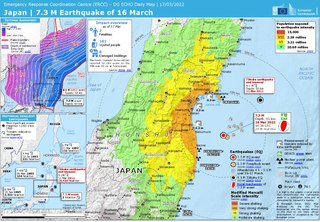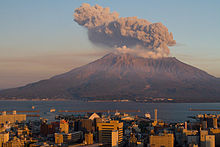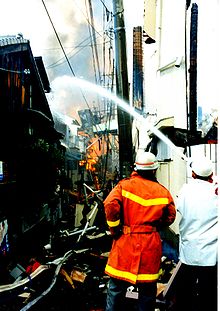
Japan is an archipelagic country comprising a stratovolcanic archipelago over 3,000 km (1,900 mi) along the Pacific coast of East Asia. It consists of 14,125 islands. The five main islands are Hokkaido, Honshu, Kyushu, Shikoku, and Okinawa. The other 14,120 islands are classified as "remote islands" by the Japanese government. The Ryukyu Islands and Nanpō Islands are south and east of the main islands.

Ōtaki is a village located in Nagano Prefecture, Japan. As of 1 April 2019, the village had an estimated population of 753 in 378 household, and a population density of 2.4 persons per km². The total area of the village is 310.82 square kilometres (120.01 sq mi). At present, Ōtaki's land area is 95% forestland; 86% of which is designated national forest.

Mount Ontake, also referred to as Mount Kiso Ontake, is the 14th highest mountain and second highest volcano in Japan at 3,067 m (10,062 ft). It is included in Kyūya Fukada's 1964 100 Famous Japanese Mountains.
The following lists events that happened during 2000 in Japan. It corresponds to the year Heisei 12 in the Japanese calendar.

The 1948 Fukui earthquake occurred in Fukui Prefecture, Japan. The magnitude 6.8 quake struck at 4:13:31 p.m.(JDT) on June 28, 1948. The quake's hypocenter was approximately 10 km north-northeast of Fukui, in the present-day neighborhood of Maruoka, Sakai City. The strongest shaking occurred in the city of Fukui, where it was recorded as 6 on the Japan Meteorological Agency seismic intensity scale.
The 1964 Niigata earthquake struck at 13:01 local time on 16 June with a magnitude of either 7.5 or 7.6. The epicenter was on the continental shelf off the northwest coast of Honshu, Japan, in Niigata Prefecture, about 50 kilometres (31 mi) north of the city of Niigata. The earthquake caused liquefaction over large parts of the city.

The 1984 Nagano earthquake hit the western part of Nagano Prefecture, Japan on September 14, 1984, at 08:48 local time. Registering a magnitude of 6.3, the earthquake destroyed Otaki, and triggered major landslides. The earthquake left at least 29 people dead or missing, making it the deadliest earthquake in 1984.

On 11 March 2011, at 14:46 JST, a 9.0–9.1 undersea megathrust earthquake occurred in the Pacific Ocean, 72 km (45 mi) east of the Oshika Peninsula of the Tōhoku region. It lasted approximately six minutes, causing a tsunami. It is sometimes known in Japan as the "Great East Japan Earthquake", among other names. The disaster is often referred to by its numerical date, 3.11.
A potent magnitude 6.6 Mw intraplate aftershock occurred at 17:16 JST (08:16 UTC) on 11 April, in the Hamadōri region of Fukushima, Japan. With a shallow focus of 13 km (8.1 mi), the earthquake was centred inland about 36 km (22 mi) west of Iwaki, causing widespread strong to locally severe shaking. It was one of many aftershocks to follow the 11 March Tōhoku earthquake, and the strongest to have its epicentre located inland.

The 2001 Geiyo earthquake occurred with a moment magnitude of 6.7 on March 24 at near Hiroshima, Japan. One person in Hiroshima and one person in Ehime were reported dead. About 3,700 buildings were damaged in the Hiroshima area. Liquefaction was observed in Hiroshima and Ehime. Power outages occurred in the prefectures of Hiroshima, Ehime, Okayama, Yamaguchi, and Kōchi. The maximum intensity was shindo lower 6 in Hiroshima. This earthquake could be felt along the eastern and southern coasts of South Korea.
This article describes the Japan Meteorological Agency (JMA) severe weather terminology. The JMA defines precise meanings for nearly all its weather terms as the Information for Severe Weather Preparation. This article describes JMA terminology and related JMA weather scales. Some terms may be specific to certain regions.
The 1968 Tokachi earthquake occurred on May 16 at 0:49 UTC in the area offshore of Aomori and Hokkaido. The magnitude of this earthquake was put at 8.3. The intensity of the earthquake reached shindo 5 in Aomori, Aomori and Hakodate, Hokkaido.

On 20 August 2014, Hiroshima Prefecture in Japan was struck by a series of landslides following heavy rain. The rain triggered 166 slope failures which included 107 debris flows and 59 shallow slides. The landslides hit residential areas including Kabe, Asakita Ward, Yagi, Yamamoto, Midorii, and Asaminami Ward. Of these areas, the Asakita and Asaminami Wards in Northern Hiroshima were hit the hardest.

The 2016 Kumamoto earthquakes were a series of earthquakes, including a magnitude 7.0 mainshock which struck at 01:25 JST on April 16, 2016 beneath Kumamoto City of Kumamoto Prefecture in Kyushu Region, Japan, at a depth of about 10 kilometres (6.2 mi), and a foreshock earthquake with a magnitude 6.2 at 21:26 JST (12:26 UTC) on April 14, 2016, at a depth of about 11 kilometres (6.8 mi).
The following is an overview of the year 2018 in Japan.

The 1847 Zenkoji earthquake occurred at about 21:30 local time on 8 May at Nagano, Japan. It had a magnitude of 7.4 on the surface wave magnitude scale. It caused the destruction of many houses in Nagano and at least 8,600 people were killed. The earthquake triggered many landslides, the largest of which dammed the Sai River. 19 days later, the failure of this earthquake dam caused a flood that destroyed many more houses and killed 35 people.

In late June through mid-July 2018, successive heavy downpours in southwestern Japan resulted in widespread, devastating floods and mudflows. The event is officially referred to as Heisei san-jū-nen shichi-gatsu gōu by the Japan Meteorological Agency. As of 20 July, 225 people were confirmed dead across 15 prefectures with a further 13 people reported missing. More than 8 million people were advised or urged to evacuate across 23 prefectures. It is the deadliest freshwater flood-related disaster in the country since the 1982 Nagasaki flood when 299 people died.

The 1982 Nagasaki flood was caused by a cloudburst that occurred mainly in Nagasaki, Japan in July 1982.

On November 22, 2014, at 22:08 local time, an earthquake struck southeast of Hakuba, Nagano Prefecture. It had a magnitude of 6.2 according to the United States Geological Survey, with a maximum intensity assigned IX (Violent) on the Modified Mercalli intensity scale. According to the Japan Meteorological Agency, it is recorded as 6.7 and at its peak intensity at Shindo 6 Lower on the Japan Meteorological Agency seismic intensity scale. The earthquake did not result in any deaths, however 41 people sustained mild to severe injuries.

On March 16, 2022, at 23:36 JST, a strong earthquake struck off the coast of Fukushima, Japan. The earthquake had a magnitude of 7.4 according to the Japanese Meteorological Agency (JMA), while the United States Geological Survey (USGS) gave an estimate of 7.3. Immediately after the event a 30‑cm tsunami was reported. The event is known in Japanese as Fukushima-ken Oki Jishin. As a result of this natural disaster, four people died and 247 were injured.

















